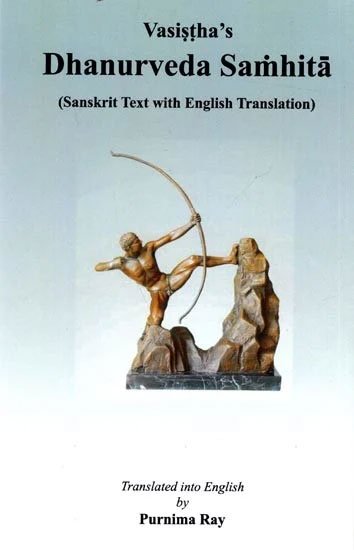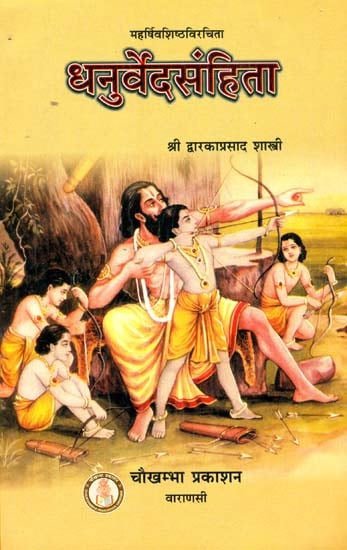Dhanurveda Samhita [sanskrit]
3,015 words
The Sanskrit text of the Dhanurveda-samhita attributed to Vasishtha. Dhanur Veda is a type of ancient India science whose roots date to the 2nd millenium BCE. It is counted among the Upavedas literature. This specific version of the Dhanurveda contains roughly 240 sections of Sanskrit text.
Verse 1.87
अङ्गुष्ठमध्यदेशन्तु तर्जन्यग्रं शुभं स्थितम् ।
सिंहकर्णः स विज्ञेयो दृढलक्ष्यस्य वेधने ॥ ८७ ॥
aṅguṣṭhamadhyadeśantu tarjanyagraṃ śubhaṃ sthitam |
siṃhakarṇaḥ sa vijñeyo dṛḍhalakṣyasya vedhane || 87 ||
Note! The following is not a translation of the above verse, but merely an arbitrary extract of the English text.
The tip of the index finger is auspiciously situated in the middle of the thumb. That lion’s ear is to be understood when piercing a strong target.
English translation by Hardayalu Swami (2001) Buy now!
Glossary of Sanskrit terms
Note: This extracts Sanskrit terms and links to English definitions from the glossary, based on an experimental segmentation of verse (1.87). Some terms could be superfluous while some might not be mentioned. Click on the word to show English definitions.
Angushtha, Adhi, Ada, Shantu, Tarjani, Agram, Agra, Shubha, Shubh, Sthita, Simhakarna, Vijneya, Dridha, Lakshya, Vedhana,
Analysis of Sanskrit grammar
Note: this is an experimental feature and only shows the first possible analysis of the Sanskrit text (Verse 1.87). If the system was successful in segmenting the sentence, you will see of which words it is made up of, generally consisting of Nouns, Pronouns, Verbs, Participles and Indeclinables. Click on the link to show all possible derivations of the word.
- Line 1: “aṅguṣṭhamadhyadeśantu tarjanyagraṃ śubhaṃ sthitam ”
- aṅguṣṭham -
-
aṅguṣṭha (noun, masculine)[adverb], [accusative single]aṅguṣṭha (noun, neuter)[adverb], [nominative single], [accusative single]
- adhya -
-
adhi (noun, feminine)[compound], [adverb], [nominative dual], [vocative dual], [accusative dual]adhi (noun, masculine)[compound], [adverb], [nominative dual], [vocative dual], [accusative dual]adhī (noun, masculine)[compound], [adverb], [vocative single]adhī (noun, feminine)[compound], [adverb], [nominative single], [vocative single]adhī (noun, neuter)[compound], [adverb], [nominative single], [vocative single], [accusative single]√dhā (verb class 1)[aorist middle first single]√dhā (verb class 2)[aorist middle first single]√dhā (verb class 3)[aorist middle first single]√dhā (verb class 4)[aorist middle first single]
- ade -
-
ada (noun, masculine)[locative single]ada (noun, neuter)[nominative dual], [vocative dual], [accusative dual], [locative single]adā (noun, feminine)[nominative dual], [vocative single], [vocative dual], [accusative dual]ad (noun, masculine)[dative single]ad (noun, neuter)[dative single]
- śantu -
-
śantu (noun, masculine)[compound], [adverb]śantu (noun, neuter)[compound], [adverb], [nominative single], [vocative single], [accusative single]śantu (noun, feminine)[compound], [adverb]
- tarjanya -
-
tarjanī (noun, feminine)[compound], [adverb], [nominative single], [vocative single]
- agram -
-
agram (indeclinable)[indeclinable]agra (noun, masculine)[adverb], [accusative single]agra (noun, neuter)[adverb], [nominative single], [accusative single]agrā (noun, feminine)[adverb]
- śubham -
-
śubha (noun, masculine)[adverb], [accusative single]śubha (noun, neuter)[adverb], [nominative single], [accusative single]śubhā (noun, feminine)[adverb]śubh (noun, feminine)[accusative single]
- sthitam -
-
sthita (noun, masculine)[adverb], [accusative single]sthita (noun, neuter)[adverb], [nominative single], [accusative single]sthitā (noun, feminine)[adverb]√sthā -> sthita (participle, masculine)[accusative single from √sthā class 1 verb]√sthā -> sthita (participle, neuter)[nominative single from √sthā class 1 verb], [accusative single from √sthā class 1 verb]
- Line 2: “siṃhakarṇaḥ sa vijñeyo dṛḍhalakṣyasya vedhane ”
- siṃhakarṇaḥ -
-
siṃhakarṇa (noun, masculine)[nominative single]
- sa -
-
sa (noun, neuter)[compound], [vocative single]sa (noun, masculine)[nominative single]
- vijñeyo* -
-
vijñeya (noun, masculine)[nominative single]
- dṛḍha -
-
dṛḍha (noun, masculine)[compound], [vocative single]dṛḍha (noun, neuter)[compound], [vocative single]
- lakṣyasya -
-
lakṣya (noun, masculine)[genitive single]lakṣya (noun, neuter)[genitive single]√lakṣ -> lakṣya (participle, masculine)[genitive single from √lakṣ class 1 verb], [genitive single from √lakṣ class 10 verb]√lakṣ -> lakṣya (participle, neuter)[genitive single from √lakṣ class 1 verb], [genitive single from √lakṣ class 10 verb]
- vedhane -
-
vedhana (noun, neuter)[nominative dual], [vocative dual], [accusative dual], [locative single]
Other editions:
Also see the following editions of the Sanskrit text or (alternative) English translations of the Verse 1.87
Dhanurveda Samhita (धनुर्वेदसंहिता)
by Hardayalu Swami (2001)
Publisher: Khemraj Shrikrishnadass
Buy now!
Vasistha’s Dhanurveda Samhita
by Purnima Ray (2023)
Publisher: Khemraj Shrikrishnadas; ISBN-10: 818670289X; ISBN-13: 9788186702895; 88 pages including 18 illustrations;
Buy now!
Dhanurveda Samhita (धनुर्वेदसंहिता) (संस्कृत एवं हिंदी अनुवाद)
by Shri Dwarka Prasad Shastri (2007)
Title: Dhanurveda Sanhita (Hindi translation); Publisher: Chaukhambha Prakashan, Varanasi; 84 pages including 11 illustrations; Author: महर्षि वशिष्ठ (Maharshi Vashistha); Foreword by Dr. Chakradhar Bijalwan.
Buy now!![Dhanurveda Samhita [sanskrit] - book cover](/uploads/a/Dhanurveda-Sanskrit.jpg)

